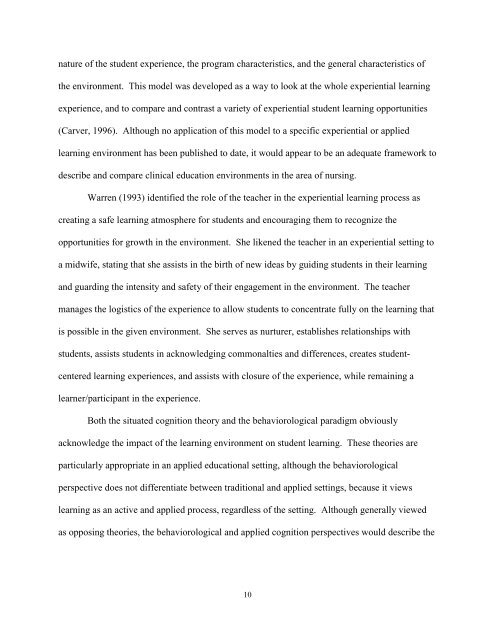STUDENT EVALUATION OF CLINICAL EDUCATION ENVIRONMENT
STUDENT EVALUATION OF CLINICAL EDUCATION ENVIRONMENT
STUDENT EVALUATION OF CLINICAL EDUCATION ENVIRONMENT
Create successful ePaper yourself
Turn your PDF publications into a flip-book with our unique Google optimized e-Paper software.
nature of the student experience, the program characteristics, and the general characteristics of<br />
the environment. This model was developed as a way to look at the whole experiential learning<br />
experience, and to compare and contrast a variety of experiential student learning opportunities<br />
(Carver, 1996). Although no application of this model to a specific experiential or applied<br />
learning environment has been published to date, it would appear to be an adequate framework to<br />
describe and compare clinical education environments in the area of nursing.<br />
Warren (1993) identified the role of the teacher in the experiential learning process as<br />
creating a safe learning atmosphere for students and encouraging them to recognize the<br />
opportunities for growth in the environment. She likened the teacher in an experiential setting to<br />
a midwife, stating that she assists in the birth of new ideas by guiding students in their learning<br />
and guarding the intensity and safety of their engagement in the environment. The teacher<br />
manages the logistics of the experience to allow students to concentrate fully on the learning that<br />
is possible in the given environment. She serves as nurturer, establishes relationships with<br />
students, assists students in acknowledging commonalties and differences, creates student-<br />
centered learning experiences, and assists with closure of the experience, while remaining a<br />
learner/participant in the experience.<br />
Both the situated cognition theory and the behaviorological paradigm obviously<br />
acknowledge the impact of the learning environment on student learning. These theories are<br />
particularly appropriate in an applied educational setting, although the behaviorological<br />
perspective does not differentiate between traditional and applied settings, because it views<br />
learning as an active and applied process, regardless of the setting. Although generally viewed<br />
as opposing theories, the behaviorological and applied cognition perspectives would describe the<br />
10












